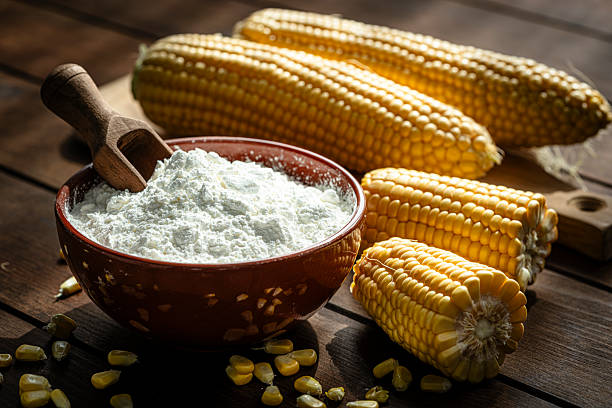The Science of Corn Starch: How It Works in Cooking and Industry
Corn starch is much more than just a kitchen thickener. In its many forms, it plays key roles in food, pharmaceuticals, paper manufacture, textiles and more. A good corn starch manufacturer turns raw corn into a refined starch that behaves predictably under heat, moisture and mechanical forces. Let’s look at what corn starch is, how it works, and why companies like Santosh Starch are important in making high quality starch for varied uses.
What is Corn Starch
Corn starch is a carbohydrate extracted from corn kernels. It is essentially pure starch, with little protein, fat or fibre. It is what remains when you remove all the outer parts of the corn kernel and then wash, dry and mill the starchy centre. Because it is almost pure starch, it is very white, tasteless, odourless and especially good at absorbing water and swelling when heated.
Starch in general comes in two natural kinds: native starch (starch as it is found in nature) and modified starch (treated to change its behaviour under certain conditions). Santosh Starch Products Limited offers both native starches (for example Santo-MSP, TSP, PSP) and more processed or “specialty” starch products.
How Corn Starch Behaves in Cooking
When used in cooking, corn starch does several things:
- Thickening
when corn starch is mixed with cold water (to make“slurry”) then added to a hot liquid, its granules absorb water, swell, and burst. This thickens the liquid. The more starch relative to liquid, the thicker the result. Because corn starch is neutral-tasting, it does not interfere with flavour. - Gel Formation
once heated and then cooled, some of the starch forms a gel. For example in puddings, sauces, custards. The texture depends on how much starch, how fast heating, how much stirring. - Clarity and Gloss
Corn starch gives a translucent or glossy finish when properly cooked. It’s often used where a clear sauce or glaze is wanted. - Stability under Heat and pH
Native corn starch is fairly stable under moderate heat, but it can break down under very high temperature or very acidic or alkaline conditions. That is why modified starches (or specialty starches) are used when cooking conditions are extreme: for example very acidic sauces, or high heat cookery. Companies like Santosh Starch supply food-grade starches designed for many cooking tasks. - Freeze-Thaw Behaviour
After cooling and freezing, some starch thickened foods release water (“syneresis”). To prevent that, specialty starches or modified starches are sometimes required which have better performance during freeze-thaw cycles. Santosh offers “food-grade starches such as Santo MSP, TSP, PSP, Mayo Gel, Bake Gel, and more” which are made for such varied needs.
Industrial Uses of Corn Starch
Beyond cooking, corn starch is used in many industries. Here are some major ways:
- Food Processing: For thickening, texturising, gelling, stabilising. Santosh supplies food-grade starches (native and specialty) for these roles
- Pharmaceuticals: Starch acts as a binder in pills and tablets, helps disintegration, and ensures uniform dosage. Santosh has “advanced pharmaceutical starches engineered for high purity, excellent binding, and consistent quality” as options
- Textiles: Used in sizing (that is, applying a coating to yarn or fabric to make it less stretchy and smoother during weaving). Santosh has products such as Santo-TEX, JET, and Shot sizing solutions. These provide thin boiling starch for sizing and finishing applications.
- Paper & Packaging: Corn starch is part of adhesives, coatings, and binders used in paper, corrugated boxes, printing papers etc. Santosh produces adhesive-grade and specialty starch for paper and packaging sectors.
- Oil Well Drilling: In drilling fluids, starch helps control fluid loss (keeping the fluid from leaking into rock formations) or helping maintain the fluid’s consistency under pressure and temperature. Santosh offers non-fermenting, high temperature stable starch for fluid loss control and rheological stabilisation.
What Makes a Good Corn Starch Manufacturer?
Choosing a reliable corn starch manufacturer matters, because the performance of the starch depends greatly on purity, granule size, processing, and consistency. From what Santosh Starch shows, here are qualities to look for:
- Wide Product Range: Different applications need different starch types. Native vs specialty; food-grade vs industrial. Santosh offers over 65 products for many industries: food, paper, chemicals, textiles, pharmaceuticals, cosmetics etc.
- Consistent Quality and Purity: For sensitive uses, like food or pharmaceuticals, the starch must meet safety and regulatory standards. Santosh’s pharmaceutical starches are noted for high purity.
- Adapted to Specific Conditions: If cooking method involves high acid, freeze/thaw, or extreme heat, then standard native starch might break down. Specialty starches are made for those tougher situations. Santosh provides both native and processed forms.
- Technical Support & Documentation: For industry clients, being able to request samples, get technical data, safety sheets etc, helps make predictable outcomes. Santosh offers ways to request samples, documents, and quotes.
- Stable Supply & Export Capability: Especially for large-scale users, having a manufacturer with capacity and ability to export reliably is important. Santosh serves international markets; its products are exported.
Corn Starch in Everyday Cooking: Best Practices
To get the best results at home when cooking with corn starch, these simple rules help:
- Make Slurry
Always mix starch with cold liquid first before adding to hot. Otherwise lumps form. - Gentle Heat First, Stir Well
Begin heating slowly, stirring steadily. Once starch granules swell, thickness comes quickly. - Watch Timing
Overheating or boiling too long can break down starch, thinning the sauce. - Cool carefully
if cooling or refrigerating cooked starch-thickened foods chill gently and avoid sudden temperature drops to reduce water separation. - Adjust for Acidity or Stable Heat
For recipes with acid (like citrus, vinegar) or long cook times, you may need starch made for stability; ordinary corn starch may lose thickening.
Scientific Basis: What Happens at Molecular Level
- Granules and Gelatinisation
Starch granules are small, semi-crystalline structures. As temperature rises in presence of water, they absorb water, lose crystalline order, swell, and then “gelatinise”. That transition is what thickens liquids. - Retro gradation
after cooling, some starch molecules (especially amylose) tend to realign and expel water. That causes a gel to firm up or becomes stiffer, sometimes squeezing out water (syneresis). Modified or specialty starches try to reduce unwanted retro gradation. - Viscosity vs Clarity
more amyl pectin gives a clearer gelatinisation; more amylose may give stronger gel. The balance of these starch components influences how the sauce or product looks and feels.
How Santosh Starch uses These Principles
Santosh Starch Products Limited, based in Ahmedabad, India, shows how these starches science ideas come into practice:
- They supply native starches (such as MSP, TSP, and PSP) for simpler functions where standard thickening or stabilising is needed.
- For food use, they provide both native and speciality food-grade starches, with items like Santo-Mayo, Bake Gel etc, suited for gel-like behaviour, texture in bakery, or stable thickening.
- In pharmaceuticals, their starches (e.g. Santo-Pharm, Pharm Gel, Decagel) are made to high purity, and serve functions like tablet binding and disintegration. These require that molecular behaviour be very consistent.
- In tough industrial environments, for example oil well drilling, they have starch that is stable at high temperature, non-fermenting, good for rheological control.
Challenges and Limitations
Even though corn starch is versatile, there are limits:
- It loses thickening power if overheated for too long or boiled strongly once thickened.
- Acidity or extremes in pH can cause breakdown or loss of viscosity.
- Storage and moisture control matter: if starch is too moist or exposed to humidity, performance suffers.
- Native corn starch may not perform well in freeze/thaw without special formulation.
Manufacturers like Santosh address these by offering modified or specialty starches with improved stability, clarity, gel texture etc.
Why Corn Starch Matters
Corn starch is a kind of building block; from sauces and soups in your kitchen to tablets in medicine, from sizing on fabrics to binding paper jackets. Its science is simple yet sophisticated. When it works well, outcomes are smooth, consistent, and reliable.
Factories like Santosh Starch Products Limited make sure that what reaches consumers or industrial kitchens performs as the user expects. They adjust production, testing, documentation to meet varying needs. Because of that, corn starch is not just a commodity — it is a technical ingredient that supports many parts of our daily lives.
Final Thoughts
Corn starch seems commonplace, but behind every teaspoon is a world of science — of granules, water, heat, molecular structure. Whether making gravy, baking a cake, pressing textiles, or making pharmaceuticals, understanding how corn starch works helps get results right. Choosing a well-reputed corn starch manufacturer ensures that the starch you use will behave as expected.
For home cooks, knowing about slurry, correct heating, and matching the starch type to your recipe can make a huge difference. For industrial users, working with manufacturers that offer consistent quality, the right product variant and good documentation is essential.
Corn starch might be simple, but it is strong. It holds sauces, shapes tablets, and helps materials work in ways we often take for granted.
If you’re interested in more industry-focused business articles, visit OverlyPost.












